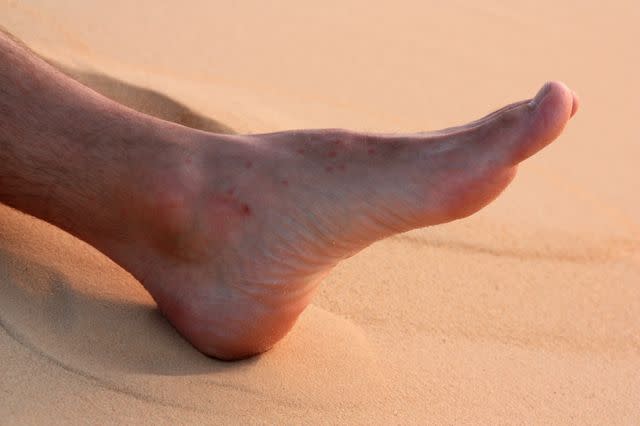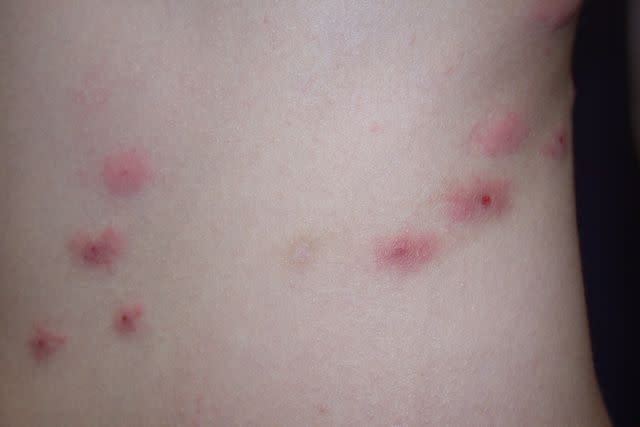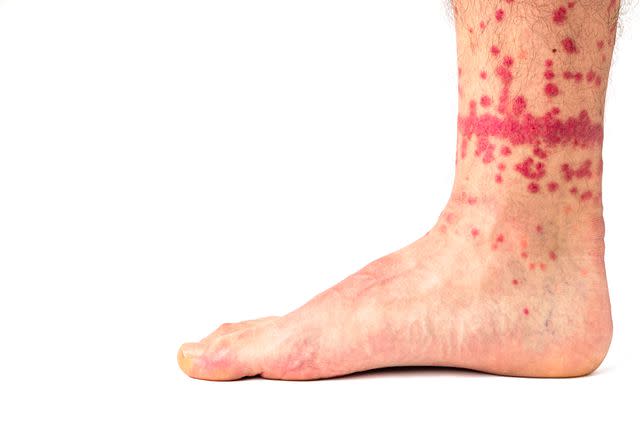How to Treat and Treat Itchy, Painful Sand Flea Bites
Medically reviewed by Susan Bard, MD
Sand flea bite pictures can help you identify what these bites look like on humans if you or someone you know has an encounter with these small animals.
The term “sand fleas” is often used to describe any number of tiny organisms found on the beach, from sand flies and gnats to tiny crustaceans. Most of these creatures are harmless and don’t cause any problems.
However, sand fleas (Tunga penetrans) are insects that thrive in subtropical and tropical environments. When adult female sand fleas burrow into the skin, they can cause a condition known as sand flea disease (tungiasis).
In this article, we’ll show you sand flea pictures and go over everything you need to know about sand fleas, including what they are and where they live as well as treatment options for sand flea disease.

aroundtheworld.photography / Getty Images
What Are Sand Fleas?
Sand fleas, or Tunga penetrans, are parasitic insects that feed on the blood of live hosts, including humans.
The sand flea is known by many other names, including:
Jigger flea
Chigoe flea
Suthi
Nigua
Chica
Pico
Unlike regular fleas, which lay eggs on the surface of the skin, sand fleas burrow into the skin of the host. While males can bite, it's only the mated female sand fleas that burrow into the skin. They will stay in the skin and feed until they are ready to shed their eggs.
Where Do Sand Fleas Live?
Tunga penetrans can be found in sandy areas, such as beaches, farms, and stables. Sand fleas are especially widespread in rural areas where dirt floors are common. They thrive in many subtropical and tropical climates around the world.
Sand fleas are often found in remote, sandy parts of:
Mexico
South America
The West Indies
Sub-Saharan Africa
India
Sand fleas aren’t native to the United States. However, they can sometimes be carried here by international travelers.
Pictures of Sand Flea Bites: What Do They Look Like?
Sand fleas are very tiny and usually penetrate the toes or feet. After burrowing under the skin they typically form a white, disc-like shape with a black point at the center.

Reproduced with permission from © DermNet dermnetnz.org 2023.
Flea bitesOver time, the round skin lesion gets darker until it is uniformly black. There may also be inflammation, pain, swelling, and itching in the affected area of the skin.
You can view an images of flea bites below:

anamariategzes / Getty Images
Flea bitesWhat Are the Risks of Sand Flea Bites?
Most bites from organisms referred to as sand fleas don’t cause any long-lasting harm. Most symptoms, such as itching and inflammation, should resolve on their own or with over-the-counter (OTC) treatment.
However, some people who are exposed to T. penetrans develop sand flea disease (tungiasis), a condition that can lead to serious health complications.
Sand Flea Disease (Tungiasis)
Tungiasis, also known as sand flea disease, is a tropical disease caused by adult female sand fleas burrowing into the skin. They leave behind circular lesions in the toes or feet that often get irritated, itchy, and inflamed.
Complications of tungiasis may include:
Infection
Abscesses
Difficulty walking
Permanent disfigurement of the feet
Chronic pain
Ulcers
Loss of nails
Tetanus
Sand flea disease is especially common in low-income areas of sub-Saharan Africa, Central and South America, and the Caribbean. Older people, people with disabilities, and boys ages 5 to 14 years are disproportionately likely to develop the condition.
How to Treat Sand Flea Bites
Research suggests that around 80% of sand fleas can be killed within about a week by topical dimethicone oil, which is usually used to treat head lice.
To avoid infection, it’s important to not scratch your bites too much or try to extract sand fleas on your own. A clinician may be able to manually extract the fleas from your skin lesions using sterile surgical instruments. They may also recommend a tetanus booster if you’re not up to date.
If you’re bitten by any other species of fleas or other organisms that are sometimes called sand fleas, you can treat itchy bumps with topical corticosteroids (such as hydrocortisone) or oral antihistamines.
Common Sand Fleas
Tiny crustaceans called Tunga penetrans are commonly found on beaches in subtropical and tropical environments, giving them the name sand fleas. You can identify bites by how they look. At first, you may see a whitish disc with a dark point in the middle. Eventually, the middle darkens and the lesion turns entirely black.
How Are Sand Flea Bites Diagnosed?
Healthcare providers can diagnose sand flea bites and/or sand flea disease with a visual inspection of the affected area of the skin. They may also ask you about your symptoms and medical history, as well as recent travel.
Mechanical extraction (with the help of a healthcare provider) can also aid in the diagnostic process. In addition to relieving symptoms, this can help to identify both the fleas themselves and their eggs.
Preventing Sand Flea Bites
Let's face it, if you're on the beach, there is a good chance you'll be walking barefoot. Sand fleas will seize the opportunity for an easy meal. When they bite, they are often found between the toes or under toe nails.
To prevent sand flea bites, make sure to wash your feet regularly and often using soap. Pay close attention to between your toes and under your toe nails.
You can also use a repellent based on coconut oil when you're in an area where you may get sand flea bites. Apply the repellent to your feet twice a day to help prevent fleas from penetrating the skin.
Outlook for Sand Flea Bites
If left in the skin, sand fleas will shed eggs for a period of about two weeks. After they are done shedding eggs, the fleas die and will be cast off by the host's skin.
It's important to keep the wound clean because secondary bacterial infections can also occur. Tetanus and gangrene are not uncommon for tungiasis.
When to Contact a Healthcare Provider
In most cases, sand flea bites aren’t dangerous. Topical OTC treatments, time, and self-care often help to relieve symptoms.
However, you should reach out to a healthcare provider if:
Your symptoms aren’t going away or are getting worse.
You have trouble walking.
You’re in pain.
You notice any signs of infection, such as fever, pus, or skin that is warm to the touch.
Summary
Sand flea bites (and sand flea disease) aren't common in the United States, but they are possible. Humans can get sand flea bites by walking barefoot in areas where sand fleas are common. These pictures can help you recognize the symptoms of sand flea bites on humans. You'll likely find bites between the toes or under toe nails.
If you notice any signs of skin inflammation or irritation after visiting the beach, talk to a healthcare provider about treatment options. In the meantime, try to avoid touching the affected area too much in order to prevent infection and other complications.
Read the original article on Verywell Health.

